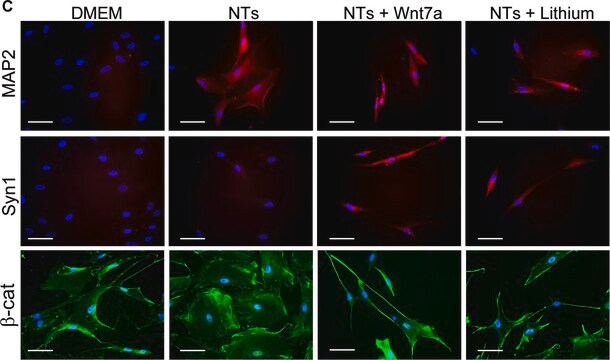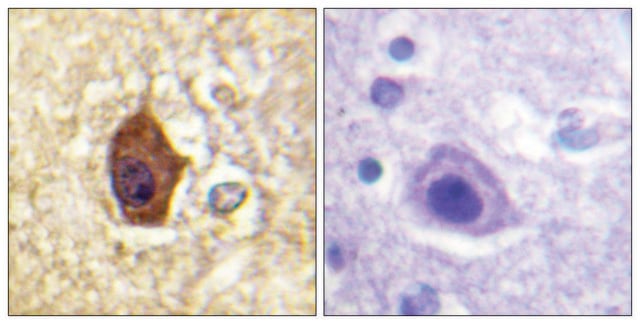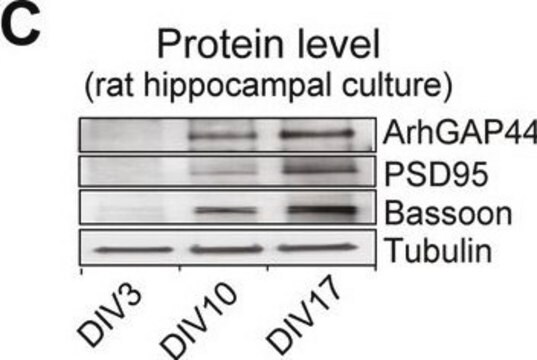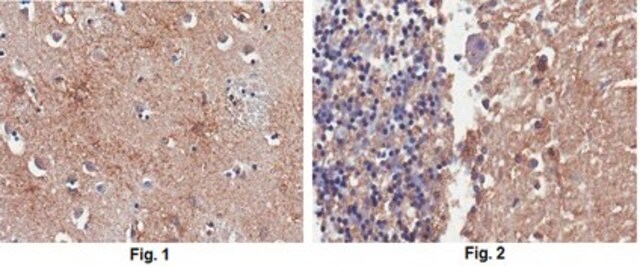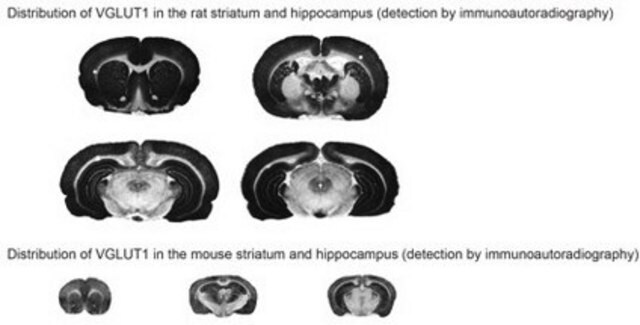574777
Anti-Synapsin I Rabbit pAb
lyophilized, Calbiochem®
Sign Into View Organizational & Contract Pricing
All Photos(1)
About This Item
UNSPSC Code:
12352203
Recommended Products
biological source
rabbit
Quality Level
antibody form
affinity isolated antibody
antibody product type
primary antibodies
clone
polyclonal
form
lyophilized
does not contain
preservative
species reactivity
human, rat, mouse, bovine
manufacturer/tradename
Calbiochem®
storage condition
OK to freeze
isotype
IgG
shipped in
ambient
storage temp.
−20°C
target post-translational modification
unmodified
Gene Information
mouse ... Syn1(20964)
General description
Immunoaffinity purified rabbit polyclonal antibody. Recognizes the synapsin I protein.
Recognizes the synapsin I protein in rat brain.
This Anti-Synapsin I Rabbit pAb is validated for use in ELISA, Immunoblotting Immunocytochemistry Immunoprecipitation for the detection of Synapsin I.
Immunogen
Bovine
purified, brovine brain synapsin I
Application
ELISA (1:2500-1:10,000)
Frozen Sections (see application references)
Immunoblotting (1:200)
Immunocytochemistry (1:500-1:2500)
Immunoprecipitation (1 µg/200 µg lysate)
Frozen Sections (see application references)
Immunoblotting (1:200)
Immunocytochemistry (1:500-1:2500)
Immunoprecipitation (1 µg/200 µg lysate)
Warning
Toxicity: Standard Handling (A)
Physical form
Lyophilized from 5 mM ammonium bicarbonate.
Reconstitution
Reconstitute with 50 µl PBS. Following reconstitution, aliquot and freeze (-20°C). Avoid freeze/thaw cycles of solutions.
Analysis Note
Positive Control
Rat brain
Rat brain
Other Notes
Stone, L.M., et al. 1994. J. Neurosci.14, 301.
Mandell, J.W., et al. 1992. J. Neurosci.12, 1736.
Fletcher, T.L., et al. 1991. J. Neurosci.11, 1617.
Moore, R.Y., and Berstein, M. 1989. J. Neurosci.9, 2151.
Mandell, J.W., et al. 1992. J. Neurosci.12, 1736.
Fletcher, T.L., et al. 1991. J. Neurosci.11, 1617.
Moore, R.Y., and Berstein, M. 1989. J. Neurosci.9, 2151.
This antibody is specific for synapsin I and can be used to estimate synaptic density and synaptogenesis. Strong and specific immunolabeling of the synapsin I doublet seen in immunoblotting at a 1:200 dilution. This immunolabeling can be blocked by preadsorption of antibody with synapsin I. Variables associated with assay conditions will dictate the proper working dilution.
Legal Information
CALBIOCHEM is a registered trademark of Merck KGaA, Darmstadt, Germany
Not finding the right product?
Try our Product Selector Tool.
Storage Class Code
11 - Combustible Solids
WGK
WGK 1
Certificates of Analysis (COA)
Search for Certificates of Analysis (COA) by entering the products Lot/Batch Number. Lot and Batch Numbers can be found on a product’s label following the words ‘Lot’ or ‘Batch’.
Already Own This Product?
Find documentation for the products that you have recently purchased in the Document Library.
Kohei Koga et al.
Molecular pain, 14, 1744806918783478-1744806918783478 (2018-06-30)
Background Chronic pain is a persistent unpleasant sensation that produces pathological synaptic plasticity in the central nervous system. Both human imaging study and animal studies consistently demonstrate that the anterior cingulate cortex is a critical cortical area for nociceptive and
Kang-Yi Su et al.
The Journal of neuroscience : the official journal of the Society for Neuroscience, 27(10), 2513-2524 (2007-03-09)
Collapsing response mediator protein-1 (CRMP-1) was initially identified in brain and has been implicated in plexin-dependent neuronal function. The high amino acid sequence identity among the five CRMPs has hindered determination of the functions of each individual CRMP. We generated
Madhumita Yennawar et al.
The Journal of neuroscience : the official journal of the Society for Neuroscience, 39(24), 4814-4828 (2019-04-07)
Pathogenic mutations in cyclin-dependent kinase-like 5 (CDKL5) result in CDKL5 deficiency disorder (CDD), a rare disease marked by early-life seizures, autistic behaviors, and intellectual disability. Although mouse models of CDD exhibit dendritic instability and alterations in synaptic scaffolding proteins, studies
Alexandra Grubman et al.
Stem cell reports, 14(6), 1018-1032 (2020-05-23)
Multiple protocols have been published for generation of iMGLs from hESCs/iPSCs. To date, there are no guides to assist researchers to determine the most appropriate methodology for microglial studies. To establish a framework to facilitate future microglial studies, we first
Kazuya Kuboyama et al.
The Journal of neuroscience : the official journal of the Society for Neuroscience, 35(35), 12162-12171 (2015-09-05)
Multiple sclerosis (MS) is a progressive neurological disorder associated with myelin destruction and neurodegeneration. Oligodendrocyte precursor cells (OPCs) present in demyelinated lesions gradually fail to differentiate properly, so remyelination becomes incomplete. Protein tyrosine phosphatase receptor type Z (PTPRZ), one of
Our team of scientists has experience in all areas of research including Life Science, Material Science, Chemical Synthesis, Chromatography, Analytical and many others.
Contact Technical Service

